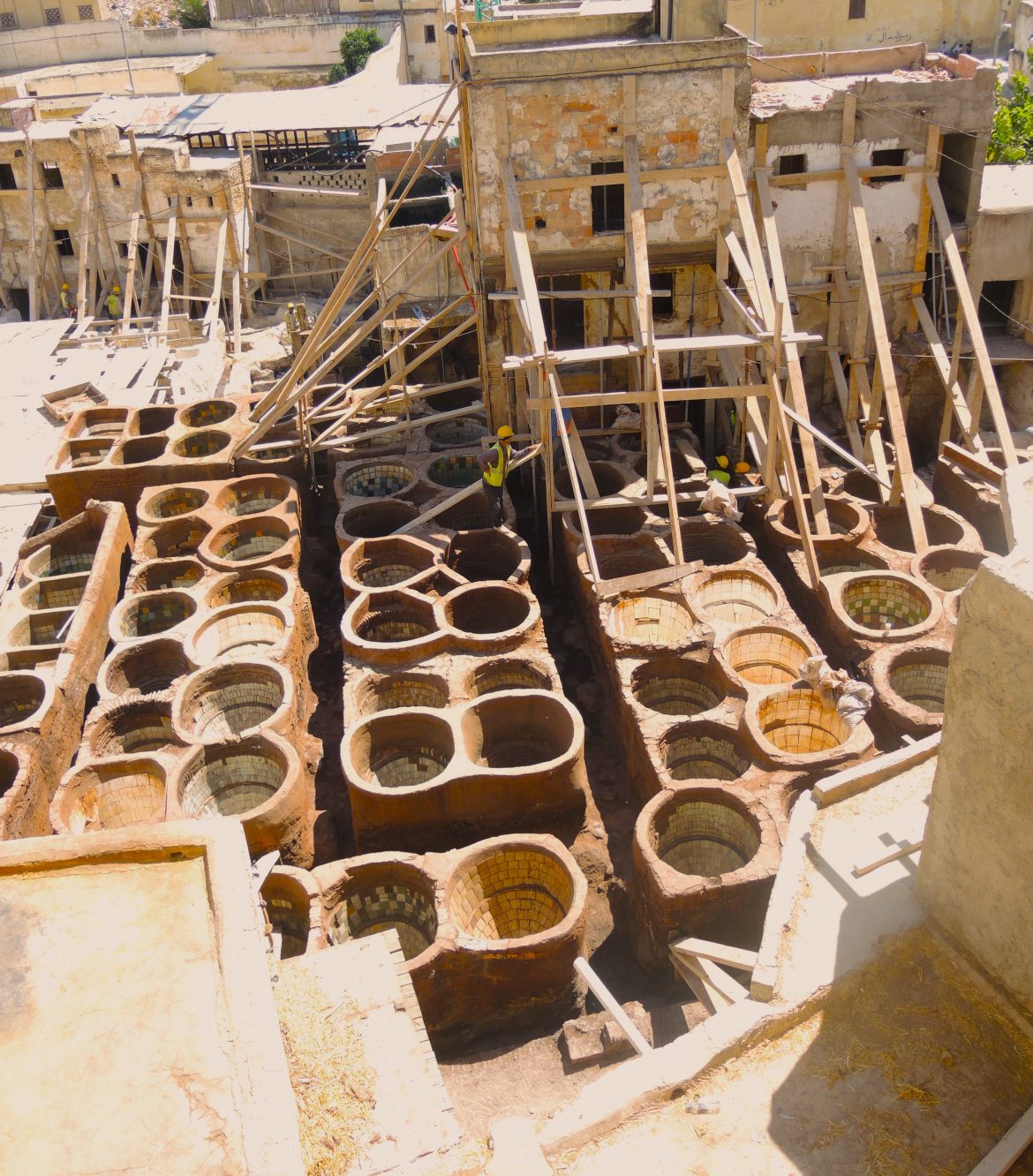Navigate to Sections
Fez offers many unique experiences for curious travelers interested in history, culture, and architecture. The best part is that most of the city’s historical sites are concentrated in and around the old walled city of Fez, Fes el Bali, and you can walk to see those attractions. Here is a walking tour guide and a history of the must-see places in Fez.
The walk starts at the gate in the old walled city of Fez, Fes el Bali, a meeting point for many guided tours and a taxi drop-off site.
Fez, founded by the Idrisids in the 8th and 9th centuries, stood at the crossroads of the trans-Saharan trade, facilitating the exchange of goods that shaped civilizations. This historical city of Morocco served as a crucial nexus, connecting the wealth of the Kingdom of Mali and Africa at large with the markets of the Mediterranean and beyond. Its strategic position made it a bustling hub where not only gold and salt from Timbuktu’s mines but also slaves and grains exchanged hands, weaving through the city’s grand bazaars before continuing their journey. Fez thrived as a cultural and economic center, its influence echoing through the ages and preserved within the labyrinthine alleys that once bustled with traders from distant lands.
Bab Boujloud
Bab Boujloud is an ancient city gate in Fez, Morocco. The term “Bab” means door in Arabic, and “Boujloud” is derived from “Abu al-Junud,” meaning “Father of the Troops,” highlighting its historical role in defense and security. The present structure, built in 1913 by the French during their colonization of Morocco, replaced a simpler gate that likely dates back to the 12th century.

Bab Boujloud, the ancient city gate in Fez, Morocco
The gate features a three-arch Moorish architectural style adorned with intricate geometric design motif tiles. Notably, one side of the gate is blue, representing the city of Fez, while the other side is green, symbolizing Islam. Bab Boujloud provides direct access to numerous historical sites, including Rue Tala’a Kebira, the main souq (bazaar) street that traverses the medina and leads to the Qarawiyyin Mosque and University at the heart of the city.
Note: Rue means street, and Derb means narrow winding alleys
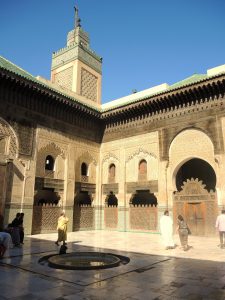
The Madrasa Bou Inania and its courtyard
La Medresa Bou Inania
Next, explore the architectural marvel of the Bou Inania Madrasa in Fez, a masterpiece of Islamic art and Merinid craftsmanship. The Medera’s green-tiled minaret is visible from Bab Bou Jeloud. Built by Sultan Bou Inan between 1351 and 1357, it served as a school and a mosque, offering instruction in Islamic studies and communal worship. This 14th-century Islamic educational and religious complex is distinguished by its typical Moroccan architecture, intricate tilework, and wood carvings. You would admire its elaborate courtyard adorned with stunning zellige tilework and cedar lattice screens. The mihrab niche features onyx columns reminiscent of the Great Mosque of Córdoba. Today, it attracts numerous tourists, providing insight into Morocco’s cultural and intellectual heritage.
Note: The madrassa closes during prayer time as it adjoins a mosque.
Zaouia/ Zawiya of Moulay Idriss II
Another stop is a Zaouia/ Zawiya of Moulay Idriss II, a Mausoleum of Moulay Idriss II, whose father, Moulay Idriss I, was the one who brought Islam to this region in the Eighth century. In Arabic, Zaouia (or Zawiya) refers to a corner where religious clerics sit with their disciples to discuss spiritual matters and teachings, typically within a mosque or madrassa (convent) courtyard. Moulay Idriss II, a revered saint in Moroccan Islam, ruled Morocco from 807 to 828 AD, preached Islamic teachings to the Berbers of Fez, and later was buried in this Zaouia. His tomb within the Zaouia is an important pilgrimage site for Muslims seeking blessings. The shrine features intricate tile work, carved wood, and decorative plaster. This UNESCO World Heritage site is in the heart of the Medina, near other landmarks such as the Al-Qarawiyyin University and Mosque, which underscores Fez’s historical importance as a hub of Islamic learning and spirituality.
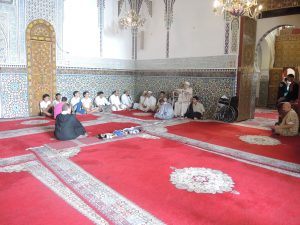
Zaouia/ Zawiya- People sitting in the corner (90 angle, Zawiya)
Scholars, poets, and artisans gathered in Fez’s madrasas (Islamic schools) and workshops. The city’s medina (old city) housed stunning architecture—mosques, palaces, and riads—reflecting Andalusian, Moorish, and Moroccan styles. Fez’s influence extended beyond its walls. Its scholars contributed to astronomy, mathematics, and medicine. The city’s craftsmanship—pottery, textiles, and leatherwork—was sought after across the Mediterranean. Fez’s legacy endures, preserved in its historic buildings, traditions, and the spirit of its people
Kairaouine Mosque (Mosque of al-Qaraouiyine)
Fez, or Fes, is renowned as the oldest and second-largest city in Morocco and as the home to one of the world’s ancient universities. The University of Al-Karaouine, located in Fes el Bali, was founded in 859 AD by Fatima al-Fihri, a devout and wealthy woman. It serves as both a mosque and a university. Recognized by UNESCO and Guinness World Records as the oldest continuously operating educational institution in the world, it remains functional to this day.
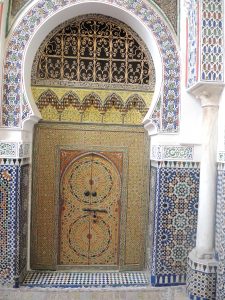
Tile Work of Zawiya Idris Moselum
The mosque features impressive architectural elements, including a large prayer hall, a beautiful courtyard, and intricate decorations. Throughout its history, this learning center has attracted scholars, philosophers, and students from across the globe, playing a crucial role in the intellectual and cultural exchange between the Islamic world and Europe.
Today, the Kairaouine Mosque continues to be a vibrant center of spiritual and cultural life, hosting religious ceremonies, lectures, and community events, and standing as a testament to Fez’s rich heritage.
In its prime, Fez was a beacon of knowledge, much like Baghdad, attracting scholars, philosophers, craftsmen, and merchants from around the globe. The city’s craftsmen built magnificent houses and palaces, while kings endowed mosques and madrasas. Merchants offered exotic goods from the Silk Roads and sub-Saharan trade routes, such as the “Gold Route.” Although Fez’s influence waned in the 19th century due to colonization, it remains a city of immense cultural and spiritual significance.
The Three – Old, New, and French Fez
Fes el Bali (Old Fez) – UNESCO World Heritage: Established between 789 and 808 AD, Fes el Bali is the oldest walled section of Fez, Morocco, and served as the capital of the Idrisid II dynasty. The medina retains its medieval charm with about 9,500 alleys and historic landmarks such as mosques, madrasas, and traditional inns. Fes el Bali is a vibrant commercial hub where artisans, traders, and shopkeepers offer various goods, from vibrant textiles to aromatic spices.
Fes el Jdid (New Fez): Founded in the 13th century by the Marinid dynasty, Fes el Jdid was designed as a royal and administrative center. It features notable landmarks like the Royal Palace (Dar al-Makhzen), beautiful gardens, and the mellah (historic Jewish Quarter). Fes el Jdid blends historical significance with vibrant local life, marked by bustling markets and traditional crafts, offering a unique fusion of historical depth and modern Moroccan culture.
Ville Nouvelle (French Fez): Extending from Fes el Jdid, Ville Nouvelle represents the French-influenced part of the city. It embodies modern life with its administrative functions, bustling markets, and traditional crafts, seamlessly integrating with Fes el Jdid and Bali’s historical richness.
Chouara Tannery
Navigate the narrow, windy streets of Fes el Bali to discover the Chouara Tannery, a practice that has mostly stayed the same for hundreds of years. The Chouara Tannery is one of the largest sites known for its traditional leather dyeing, which dates back to the 16th century. Despite modern renovations, the tannery retains an old conventional vibe, with labor-intensive processes producing high-quality leather. The surrounding shop’s rooftops offer the best view and unique perspectives of the vibrant dye pits of this medieval tannery, especially in the morning. The experience is a sensory journey through sight and smell, showcasing a craft unchanged by time. You will easily find people working at these shops to explain the process and walk you through the tanneries. Pay them small tips for their providing you with guiding services. You can also buy some good leather bags or other stuff here in Fez.
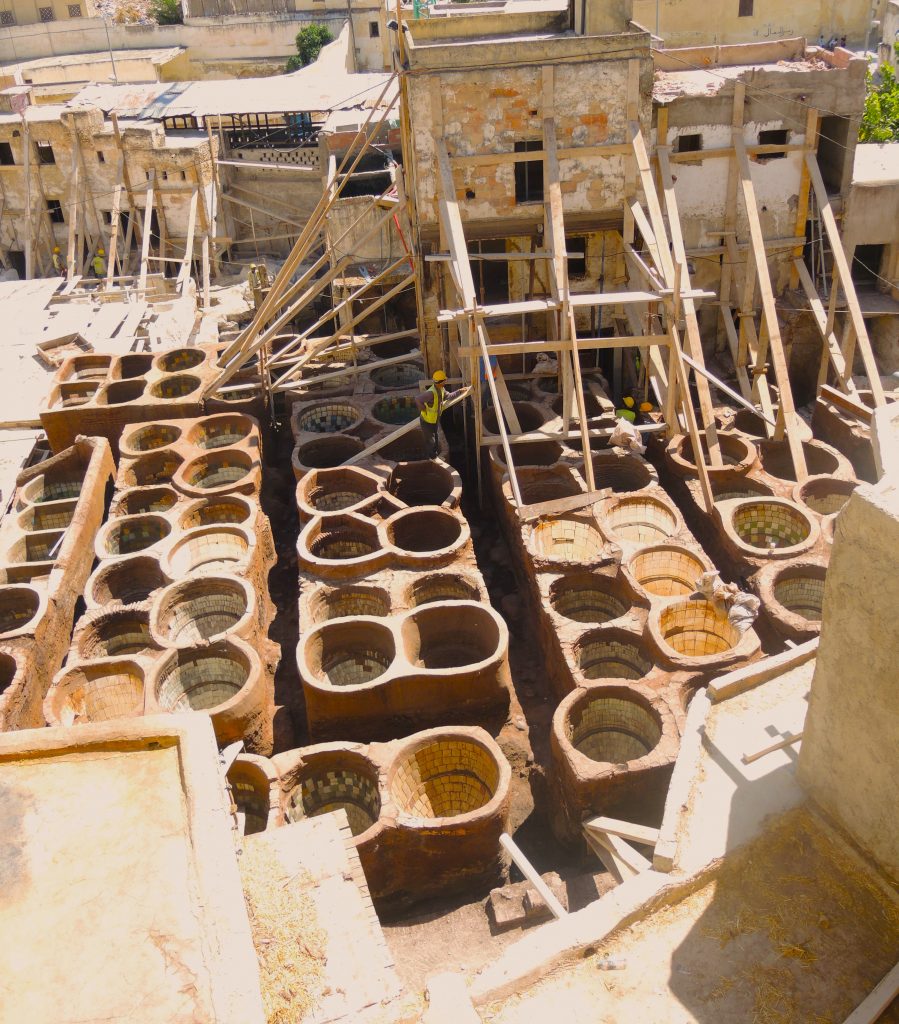
Tanneries in Fez – A view from a nearby shop’s rooftop
Disclaimer: I purchased a handbag from one of those shops. The leather and dye quality were superior for the price, but the zipper and other components needed to be of better quality and broke quickly.
Funduq al-Najjarin
Step into the past at Funduq al-Najjarin, a beautifully restored 18th-century Moroccan funduq (inn), where the rich heritage of Moroccan woodcraft comes alive. In medieval Islamic urban centers, finding structures known as funduqs was typical. With their multi-level design and central courtyard, these buildings served as a hub for travelers and traders, offering them both lodging and storage facilities for their merchandise and livestock.
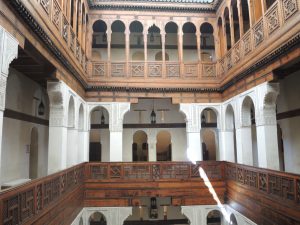
Funduq al-Najjarin- Museum
Funduq al-Najjarin is one of those funduqs in the heart of Fes el Bali; Fez’s ancient medina, located on the renowned “Trans-Saharan Route,” is a testament to this historical trade network. This two-story building, built in 1711 AD, displays its typical role in the city’s mercantile past. The ground floor was once used for storing merchants’ goods, while the upper levels provided respite for weary travelers. The building was adorned with a cedar canopy, meticulous tile work, and a mosaic fountain that served as a charitable water source for passersby. Its façade is decorated with exquisite tile work, capturing the essence of Fez’s rich cultural tapestry. This Funduq has been converted into a museum where you can explore its stunning woodwork, contrasting Amazigh traditions with Andalusian influences. Museum highlights include intricately carved doors, prayer beads, musical instruments, and the storied wooden boards of Quranic students, embellished with copper and bearing the marks of their academic achievements.
Ben Danan Synagogue
The history of Morocco, especially in Fez, has been greatly influenced by Jewish immigrants. The term “Megorashim” refers to the Jews from the Iberian Peninsula who were expelled and arrived in North Africa due to the anti-Jewish persecutions in Sapin during fourteen and fifteenth century. These individuals were distinct from the pre-existing Jewish communities in North Africa, known as Toshavim. The Ben Danan Synagogue was built in the 17th century to serve the Megorashim community. It is decorated with pretty herringbone green tiles, turquoise octagonal pillars, and glowing chandeliers. The main features of this Synagogue include the original deerskin Torah scrolls in an ark built into the wall and a mikvah (ritual bath) in the basement, filled by an underground water source. Black and white photos of other Jewish sites around Morocco are also displayed.
Pottery and Tile Workshops
To learn how Fez’s beautiful pottery and tiles are made, visit Ain Nokbi, a district just outside Medina. Ain Nokbi was previously located inside the Medina but was moved outside to protect residents from dust and kiln heat in 2013. Art Naji in Fez is renowned for its traditional Moroccan ceramics and pottery, showcasing exquisite craftsmanship through hand-painted designs. Zilij (or Zellige) tilework also features intricate geometric patterns created from hand-cut, enamel-covered terracotta tiles. This historic art form, dating back to the 10th century, adorns many of the city’s iconic architectural structures.
Note: You do not need to buy anything from the shop Art Naji. It is just for experiencing their process of tile making and handcrafting of Tajin and other pottery.
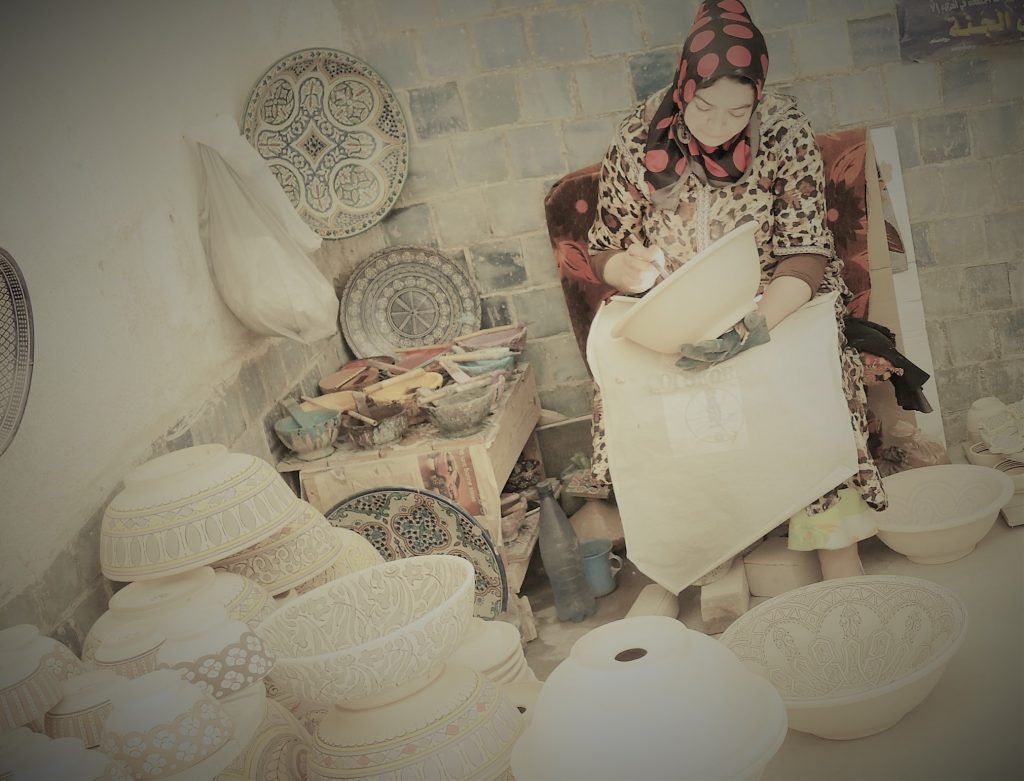
Women painting on a tajin
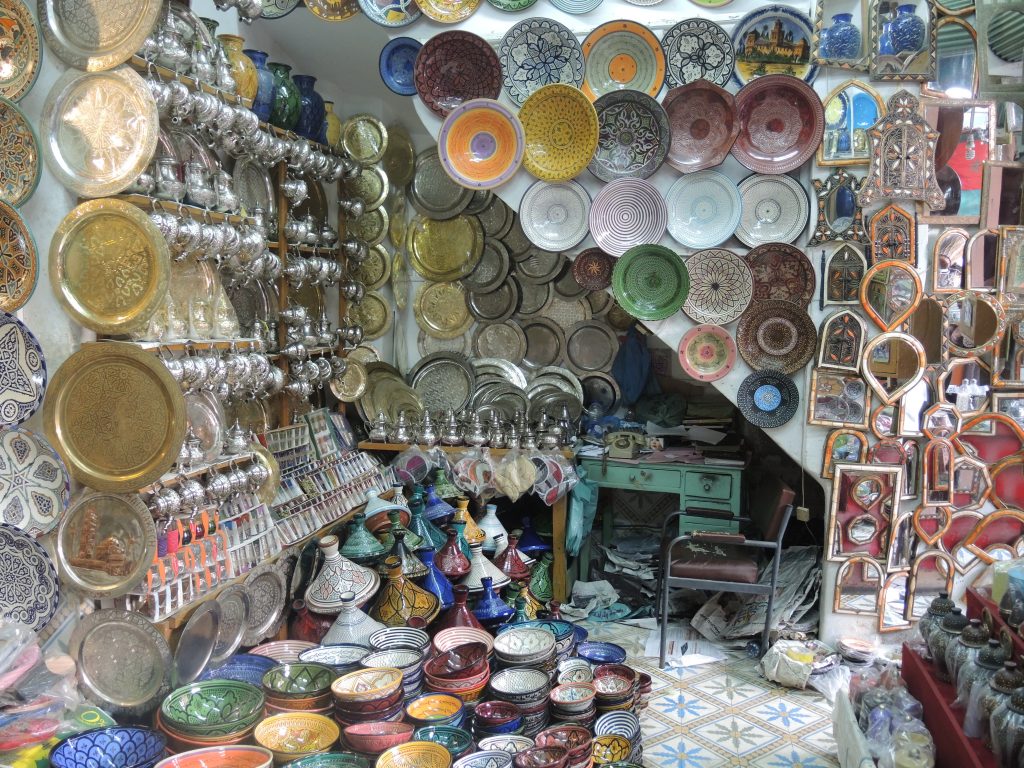
A pottery shop
